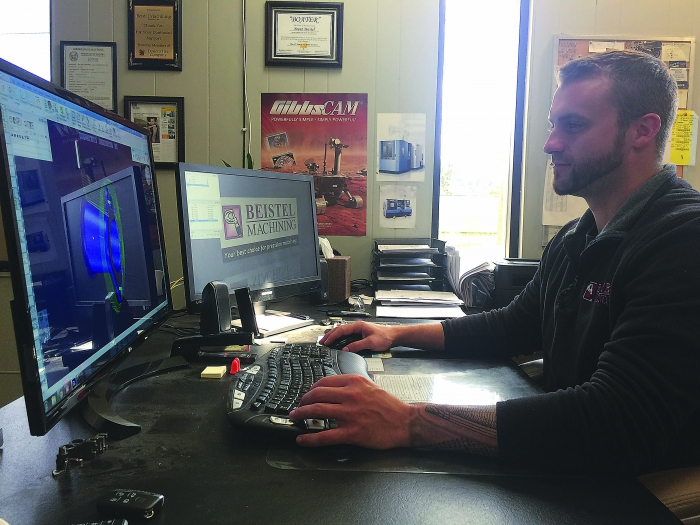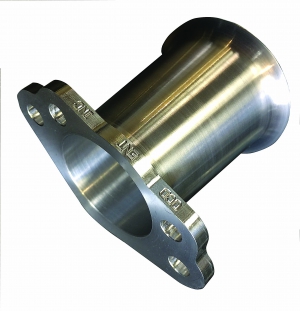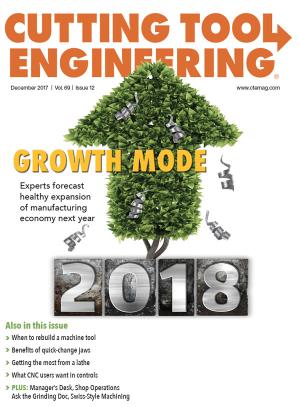Brent Beistel got his start in the metalcutting profession sweeping floors and cleaning chip pans at a machine shop soon after he completed high school. However, Beistel’s knack for producing parts eventually led to him heading the shop’s lathe department.
“Within a year of me taking over and setting up the lathes, I was programming all of them right at the machine,” Beistel said. Although the shop employed a programmer, Beistel wanted to learn to do it on his own. “Also, so I didn’t bug him for programs all the time.”
That scenario changed after he launched his own company, Beistel Machining Inc., Donora, Pa., and purchased his first CNC machine tool, a Doosan DNM 400 vertical machining center. Beistel bought the machine from Allegheny Machine Tool Systems Inc., McMurray, Pa., which is also a reseller of software from GibbsCAM by 3D Systems Inc. (www.gibbscam.com), Moorpark, Calif.

Brent Beistel installed GibbsCAM software at Beistel Machining after purchasing the shop’s first CNC machine. All images: Beistel Machining.
Beistel started with the GibbsCAM production milling option because he needed the software only for the VMC. As the job shop grew, he added options such as those for tombstone management and MTM (multitask machining).
On one program alone, Beistel said, tombstone management saved him up to 6 hours of programming time. The job required seven different work offsets for each side of the four-sided tombstone for a total of 28 different offsets. Rather than programming every individual part on every individual side of the tombstone, the option enables programming one part and duplicating it across the entire tombstone. “That also cut the work offsets from 28 to seven,” he said.
Beistel added that GibbsCAM has a reputation of being easy to use. He recalled writing a few programs and making parts with them the first day he got the software, but MTM is the package’s most complex component. “Only because there is so much you can do,” he said, adding that MTM lets the shop produce parts in one setup that previously required three or four. “You’re pretty much using everything GibbsCAM offers all in one machine.”
In one MTM application, Beistel said his company produced completed parts in two operations on a multitask machine that would have typically required two lathe operations and two milling operations. After facing the part and boring the ID in the first operation, the second operation involved loading the part onto a mandrel, groove-turning the OD, cylindrical milling (C-axis) the flange, drilling the off-center holes and inscribing the company initials on the outside of the flange.
An element of the CAM package that has universal applicability throughout the shop is the VoluMill toolpath option, Beistel emphasized. According to Moorpark-based Celeritive Technologies, the software's developer, VoluMill runs seamlessly inside GibbsCAM and other CAM systems and enables a high-material-removal-rate capability to help end users create fast, efficient toolpaths for milling. The process automatically takes into account the best option for milling pockets, including the speed of a tool plunging into the material and its mrr.

With GibbsCAM's MTM option, Beistel Machining completed this part in two operations on a multitask machine that would have typically required two lathe operations and two milling operations.
“I’ve been using it for 4 or 5 years now,” Beistel said, “and it is absolutely—by far—the best thing we use.” He estimated that VoluMill paid back its approximate $2,500 cost in about 2 months. Now, however, the option is free with each new GibbsCAM milling license.
Although still something end users must pay for, Beistel said it’s wise to include maintenance with the CAM software. Maintenance enables shops to receive software updates and support, which includes post-processor editing, at no additional cost.
When Beistel needs a new post, he said he taps into the reseller’s large library of posts for a host of different machines. If Beistel finds that a post could be improved, he’ll email the post department at GibbsCAM with the post file and machine definition document attached and a description of what he needs. For instance, he needed to activate the air blast on a multitask machine to clear chips from chuck jaws before transferring a part to the subspindle’s chuck.
“Sure enough, they emailed the post back, I posted the program, and it blew the air out,” Beistel said.
For more information about Beistel Machining Inc., Donora, Pa., visit www.beistelmachining.com or call (724) 823-0099.
Related Glossary Terms
- boring
boring
Enlarging a hole that already has been drilled or cored. Generally, it is an operation of truing the previously drilled hole with a single-point, lathe-type tool. Boring is essentially internal turning, in that usually a single-point cutting tool forms the internal shape. Some tools are available with two cutting edges to balance cutting forces.
- chuck
chuck
Workholding device that affixes to a mill, lathe or drill-press spindle. It holds a tool or workpiece by one end, allowing it to be rotated. May also be fitted to the machine table to hold a workpiece. Two or more adjustable jaws actually hold the tool or part. May be actuated manually, pneumatically, hydraulically or electrically. See collet.
- computer numerical control ( CNC)
computer numerical control ( CNC)
Microprocessor-based controller dedicated to a machine tool that permits the creation or modification of parts. Programmed numerical control activates the machine’s servos and spindle drives and controls the various machining operations. See DNC, direct numerical control; NC, numerical control.
- computer-aided manufacturing ( CAM)
computer-aided manufacturing ( CAM)
Use of computers to control machining and manufacturing processes.
- gang cutting ( milling)
gang cutting ( milling)
Machining with several cutters mounted on a single arbor, generally for simultaneous cutting.
- inner diameter ( ID)
inner diameter ( ID)
Dimension that defines the inside diameter of a cavity or hole. See OD, outer diameter.
- lathe
lathe
Turning machine capable of sawing, milling, grinding, gear-cutting, drilling, reaming, boring, threading, facing, chamfering, grooving, knurling, spinning, parting, necking, taper-cutting, and cam- and eccentric-cutting, as well as step- and straight-turning. Comes in a variety of forms, ranging from manual to semiautomatic to fully automatic, with major types being engine lathes, turning and contouring lathes, turret lathes and numerical-control lathes. The engine lathe consists of a headstock and spindle, tailstock, bed, carriage (complete with apron) and cross slides. Features include gear- (speed) and feed-selector levers, toolpost, compound rest, lead screw and reversing lead screw, threading dial and rapid-traverse lever. Special lathe types include through-the-spindle, camshaft and crankshaft, brake drum and rotor, spinning and gun-barrel machines. Toolroom and bench lathes are used for precision work; the former for tool-and-die work and similar tasks, the latter for small workpieces (instruments, watches), normally without a power feed. Models are typically designated according to their “swing,” or the largest-diameter workpiece that can be rotated; bed length, or the distance between centers; and horsepower generated. See turning machine.
- machining center
machining center
CNC machine tool capable of drilling, reaming, tapping, milling and boring. Normally comes with an automatic toolchanger. See automatic toolchanger.
- mandrel
mandrel
Workholder for turning that fits inside hollow workpieces. Types available include expanding, pin and threaded.
- metalcutting ( material cutting)
metalcutting ( material cutting)
Any machining process used to part metal or other material or give a workpiece a new configuration. Conventionally applies to machining operations in which a cutting tool mechanically removes material in the form of chips; applies to any process in which metal or material is removed to create new shapes. See metalforming.
- milling
milling
Machining operation in which metal or other material is removed by applying power to a rotating cutter. In vertical milling, the cutting tool is mounted vertically on the spindle. In horizontal milling, the cutting tool is mounted horizontally, either directly on the spindle or on an arbor. Horizontal milling is further broken down into conventional milling, where the cutter rotates opposite the direction of feed, or “up” into the workpiece; and climb milling, where the cutter rotates in the direction of feed, or “down” into the workpiece. Milling operations include plane or surface milling, endmilling, facemilling, angle milling, form milling and profiling.
- outer diameter ( OD)
outer diameter ( OD)
Dimension that defines the exterior diameter of a cylindrical or round part. See ID, inner diameter.
- toolpath( cutter path)
toolpath( cutter path)
2-D or 3-D path generated by program code or a CAM system and followed by tool when machining a part.


